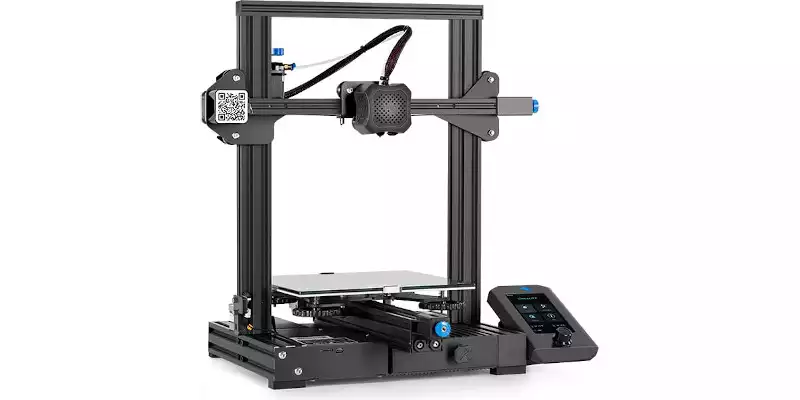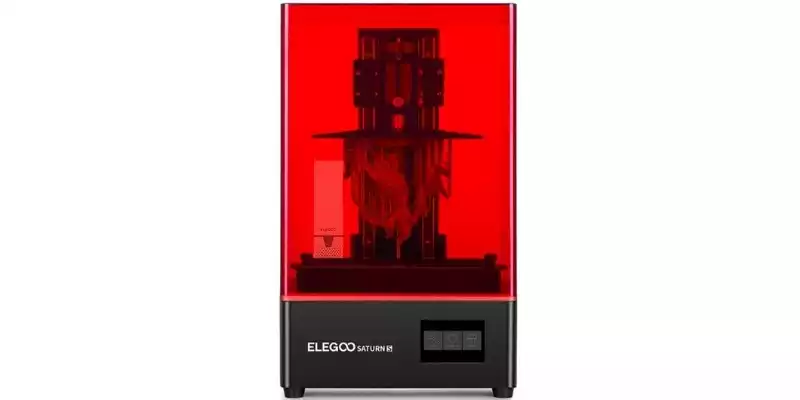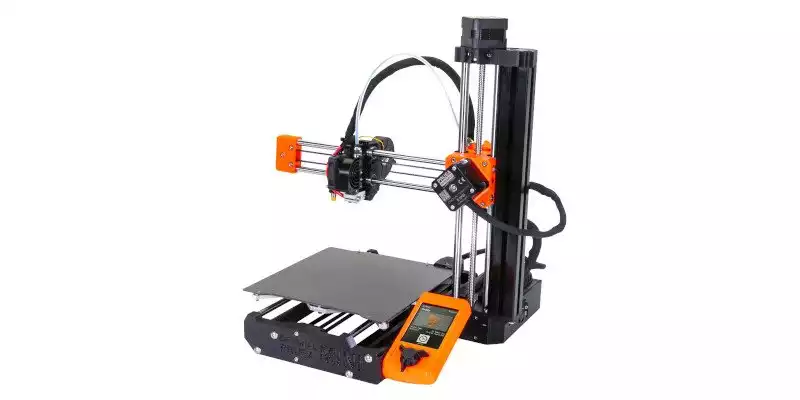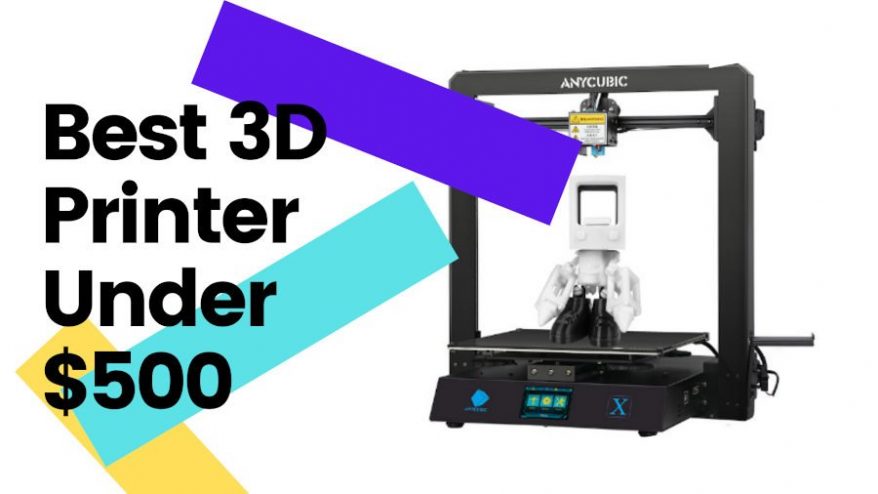
Just a decade ago the thought of desktop 3D printers that could print reasonably sized models in basic filaments like PLA and ABS without much issue was unthinkable. Your own personal 3D printer, for $500?
But now, not only do they just about get by, but in fact the best 3D printers under $500 offer great printing results, with good reliability, range of printable materials, and precision and accuracy.
|
|
|
|
|
$279.99
|
N/A
|
$399
|
|
|
I’m sure you’re interested in finding out more about these low cost 3D printers. But first, here’s what you should expect in buying a sub-$500 3D printer.
| Name | Build Volume (mm) | Price | Where to buy | Alternative purchase option |
|---|---|---|---|---|
| Creality Ender 3 V2 | 220 x 220 x 250 | $249 | Creality Store here | Amazon here |
| Anycubic Photon Mono 4K | 132 x 80 x 165 | $299 | Anycubic Store here | Amazon here |
| Ender 5 Pro | 220 x 220 x 300 | $399 | Creality Store here | Amazon here |
| Prusa Mini+ | 180 x 180 x 180 | $399 | Prusa Store here | |
| Creality CR-6 SE | 235 x 235 x 235 | $429 | Creality Store here | Amazon here |
| Qidi Tech i-Mate S | 260 x 200 x 200 | $449 | Amazon here | |
| Anycubic Mega X | 300 x 300 x 305 | $469 | Anycubic Store here | Amazon here |
| Elegoo Saturn | 192 x 120 x 200 | $499 | Elegoo here | Amazon here |
| Creality CR-10 V3 | 300 x 300 x 400 | $499 | Creality Store here | Amazon here |
What to expect in a 3D printer under $500?
More affordable 3D printers naturally sacrifice some of the advanced features commonplace on industrial 3D printers above $10,000. You also can’t expect the same flawless quality, speed, or reliability that professional 3D printers offer.
But, at this price range you can expect good quality FDM prints in PLA and perhaps a few other filaments.
Most of the best 3D printers under $500 should be able to print ABS, though many are not enclosed 3D printers which can cause difficulties with warping. You should expect reasonably quality: 100- or 50-micron minimum layer height maximum precision, and in the event of a power outage or other problem, your printer should be able to resume where it was stopped.
Best 3D Printers Under $500 2023
Based on this criteria for the best 3D printers under $500, these are the printers we recommend:
3DSourced is reader-supported. When you buy through links on our site, we may earn an affiliate commission. Learn more
Creality Ender 3 V2 — for under $300
- Price: $279 — Available on Creality Official Store here / Available on Amazon here
- Build volume: 220 x 220 x 250 mm
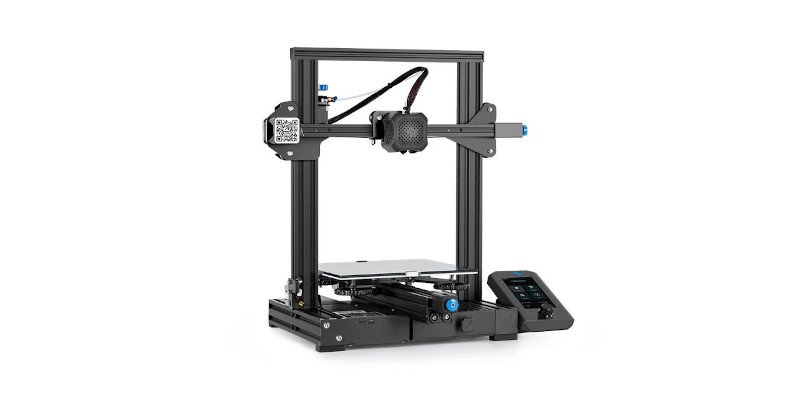
Pros
Still one of the best low-cost 3D printer kits available.
Very upgradeable.
Cons
There are now more advanced printers with newer features.
Some more expensive 3D printers nearer the $500 mark may outperform it in raw power and quality, but for the price the Ender 3 V2 offers unbeatable value. That’s why it’s currently the world’s most popular 3D printer.
The Ender 3 V2 is fairly similar to the original Ender 3, just with improved and upgraded firmware, an improved filament feeding system, a carborundum build plate, as well as an HD color screen.
This helps improve your overall printing experience, able to print precisely, consistently, and simply, with the carborundum glass build plate improving adhesion, heating up quickly, and making it easier to remove prints after.
For $279 you get a high-quality printer that prints reliably — it’s a sturdy machine. For that reason, we recommend it as it’s great value — though if you have $500 for a 3D printer other options may outperform it overall.
Anycubic Photon Mono 4K
- Price: Check on Anycubic Official store here / Amazon here
- Build volume: 132 x 80 x 165 mm
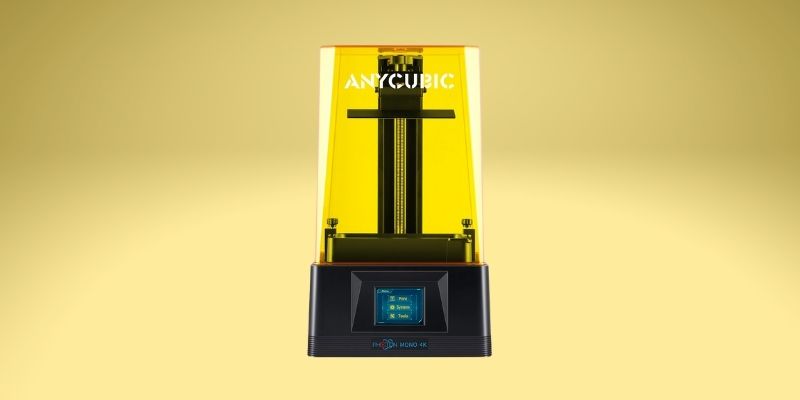
Pros
Very reliable.
The results are near perfect.
Easy to pick up for beginners.
Cons
Can be messy at times and requires regular cleaning.
Developed as a high-resolution counterpart to the popular Anycubic Mono, the Anycubic Photon Mono 4K ranks among the best sub $500 resin printers.
One of the main reasons we rate the Anycubic Photon Mono 4K is the 6.23-inch 4K monochrome LCD, capable of a layer height of 35 microns. Coupled with a 132 x 80 x 165 mm build volume, the Anycubic Photon Mono 4K is at home printing all manner of small detail-heavy parts, decorative pieces, and models.
The print results consistently display stellar textures and finish. Imperfections and blemishes are few and far between. The Anycubic Photon Mono 4K even holds its own printing articulated features. With a 1-2 second layer cure time, the Anycubic Photon Mono 4K’s print speeds are perfectly reasonable for a 3D resin printer, too.
The fact we’ve also recommended the Elegoo Saturn begs the question: why choose the Anycubic Photon Mono 4K over the Saturn? Multiple reasons, all of which make the Anycubic Photon Mono 4K a better pick for beginners.
Most pressingly, Anycubic Photon Mono 4K commands a price tag roughly half that of the Elegoo Saturn, making it far more accessible to newbies on a tighter budget. A small build volume is a trade-off here, but for those without plans for batch prints or medium-to-large models, the Mono 4K still offers plenty of volume to play with and best that learning curve.
Anycubic has also gone to lengths to simplify the printing process for beginners. Fully-assembled shipment, minimal setup, and an intuitive slicer in Anycubic’s in-house Photon Workshop should see you printing impressive models in no time at all. Should you want to expand your horizons with advanced tinkering features, the Anycubic Photon Mono 4K also plays nice with third-party resin slicers like Lychee and ChiTuBox.
If you need a small form factor resin 3D printer at a competitive price, you can’t beat the Anycubic Photon Mono 4K, in our opinion.
Creality Ender 5 Pro
- Price: $399 — Available on Creality Official Store here / Available on Amazon here
- Build volume: 220 x 220 x 300 mm
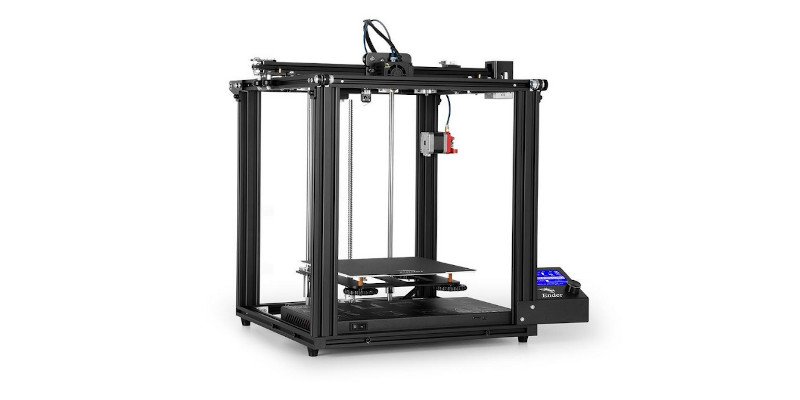
Pros
Highly modifiable.
Quiet operation.
Affordable and great print quality.
Cons
Manual bed leveling.
Despite the large size, the Ender 5 Pro’s upgraded mainboard keep it quiet — it won’t wake you up from the next room along with its loud roaring.
Featuring Creality’s upgraded and new metal extruder, the Ender 5 Pro offers even better precision as the added strength makes for better-targeted deposition and more precise forces to exert on filament during the extrusion process. The quieter mainboard and upgraded metal extruder are two crucial and underrated upgrades the Ender 5 Pro offers over the standard Ender 5.
As with all Creality 3D printers it’s easy to assemble, and shouldn’t take even beginner makers more than an hour. And in the event you do run into any trouble, you can contact Creality’s support team who will gladly help.
The cube structure makes it a stable, sturdy, and anchored-down 3D printer. This benefits your printing experience as the stability prevents any vibrations or any other forces from creating shaky prints with imperfections, leaving you with smooth and accurate prints every time.
The large size will be important to those looking to print big structures, or parts of even larger sculptures, characters or large-scale prototypes. Overall, the Ender 5 Pro is a great 3D printer under $500 with its size, accuracy, and consistency.
Prusa Mini+
- Price: $399 — Available on Prusa Store here
- Build volume: 180 x 180 x 180 mm
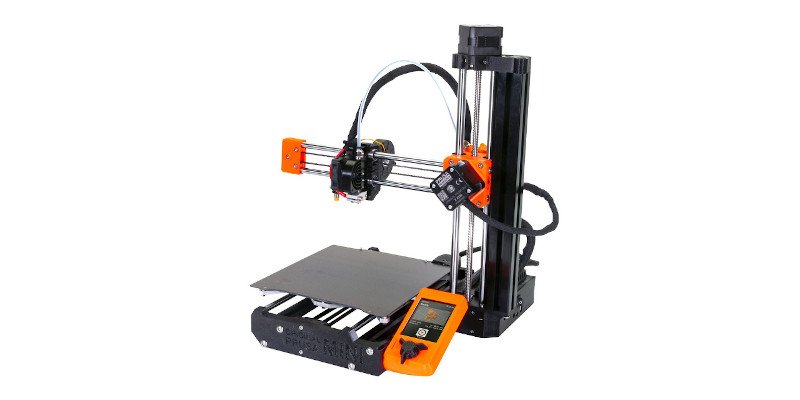
Pros
Like all Prusa printers, it’s durable and reliable.
Fast 200mm/s print speeds.
Cons
Small print area.
The mini version of the incredibly successful Prusa i3 range, if you want the reliability and workhorse-like ruggedness of the Prusa in a bite-sized package, this one’s for you.
Available either for $399 in a simple 3-piece assembly, or as a DIY kit if you want to save $50, it’s an ideal 3D printer for beginners looking to print straight away, as well as for seasoned makers or businesses looking to get printing or prototyping.
- The full-size Prusa i3 MK3S is also available if you’ve got the budget — Available on Prusa Store here
The color LCD screen makes it easy to navigate with clear color icons, and includes Prusa’s flexible print sheets that make removing finished prints easier than ever. It can’t reach the same temperatures as the i3 MK3S, but for a 3D printer under $500 you can’t expect industrial-level material printing.
The Prusa Mini+ is compact, and can fit neatly on the side of a desktop (or if you’re looking to put together a print farm, several can sit together without taking too much space), and you of course get Prusa’s signature reliability. Overall, as a small-ish 3D printer under $500, it’s one of the best out there.
Creality CR-6 SE – Top Pick for Convenience and Ease-Of-Use
- Price: Check on Creality Store here / Amazon here
- Build volume: 235 x 235 x 250 mm

Pros
Good features for ease of use.
Automatic bed leveling system.
4.3-inch HD touchscreen.
Cons
More expensive than the similar Ender 3 V2.
An ill-fated Creality CR-6 SE Kickstarter campaign saw Creality hemorrhage goodwill among backers, with dodgy power switchers, scorched boards, and shipping delays, among other issues.
However, Creality got to work and remedied all these initial teething issues, public apology in tow, and any Creality CR-6 SE purchased now ships with all these issues fixed. As it stands, the Creality CR-6 SE is a potent 3D printer that justifies its under $500 price tag.
There’s very little to differentiate the Creality CR-6 SE from Creality’s excellent budget Ender 3 V2 in both looks and print quality. So, if the Creality CR-6 SE is so similar to the Ender 3 V2, why spend that extra $100? It all comes down to a nifty set of features and parts that scream ease of use.
Leading the Creality CR-6 SE bid as a worthy alternative to the Ender 3 V2 is an automatic bed leveling system. The hot end acts as a strain gauge that determines the adjustments needed based on recorded resistance at 16 points on the bed – no more time lost with pesky paper-led manual leveling.
Few other best 3D printers under $500 deliver automatic bed leveling. Let alone in the same consistent, hassle-free way as the Creality CR-6 SE. In our experience, the printer provides a perfect first layer without fail.
A new 4.3-inch HD color touch screen affords intuitive and responsive controls, miles better than the approximate dial on the Ender. The Creality CR-6 SE also upsizes the Ender’s build volume by a few millimeters to 235 x 235 x 250 mm. That’s enough to tackle the overwhelming majority of hobbyist projects out there, from functional household items to decorative pieces, by way of modest same-part batch printing.
Creality CR-6 SE houses several other, more technical changes over the Ender 3 V2, such as dual drive Z-axis stepper motors, a new sophisticated extruder design, and a photoelectric filament sensor. Sleek, and a talking point, but they don’t necessarily translate to better print results. It performs identically to the Ender when using PLA, which means smooth layer lines, small detailed features, and an overall, consistently excellent quality prints.
Overall, Creality CR-6 SE offers just enough to make it an attractive choice over the Ender 3 V2. If the hands-on approach of the Ender 3 V2 doesn’t sit well with you, the Creality CR-6 SE’s convenience and ease of use features come highly recommended for beginners and thrifty makers alike.
Qidi Tech i-Mate S — best 3D printer under $500 with enclosure and dual extruder
- Price: $449 — Available on Amazon here
- Build volume: 260 x 200 x 200 mm
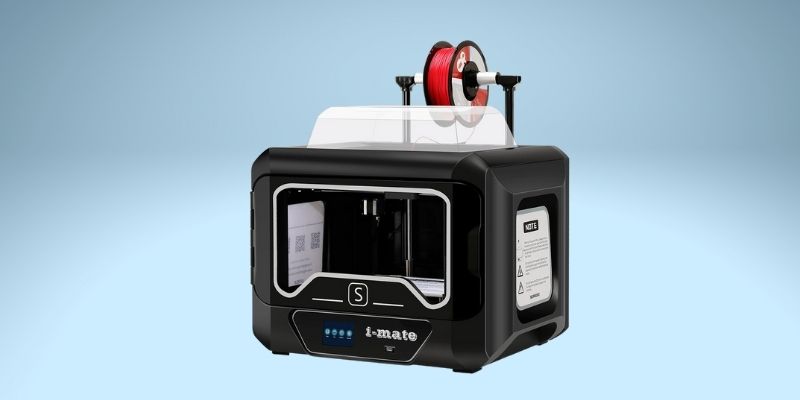
Pros
Sturdy and robust.
Great for printing miniatures.
Comes with a 0.2mm nozzle, for printing intricate prints more accurately.
Cons
Manual bed leveling.
We previously featured the Qidi Tech X-Pro on this list, and have consistently rated it as one of the best 3D printers under $500 with an enclosure. However, technology moves on, and Qidi have now released its heir apparent, the Qidi Tech i-Mate S.
It’s sturdily and robustly built with a full metal frame that fully encloses the build area, so you can far better print ABS in the closed chamber and better maintain the temperature to prevent warping. The metal frame also anchors the printer down, preventing vibrations from affecting your print quality.
If you’re looking for a 3D printer under $500 for 3D printing miniatures, this might be the printer for you. Qidi Tech ship the i-Mate S with a 0.2mm nozzle, rather than the standard 0.4mm nozzle (though a 0.4mm also comes with the printer), for printing intricate prints more accurately and nailing the detail on intricate models.
Overall, it’s a 3D printer that comes assembled, has an enclosure, and great build volume, at an affordable price.
Anycubic Mega X — best 3D printer under $500 for large prints
- Price: $469 — Available on Anycubic Official Store here / Available on Amazon here
- Build volume: 300 x 300 x 305 mm

Pros
Big build volume.
Easy assembly.
Strudy metal frame to prevent vibrations.
Cons
Can be pretty loud.
A big 3D printer capable of much larger 3D printing projects, cosplay parts, or printing multiple smaller objects at the same time, the Anycubic Mega X offers a lot of bang for your buck.
It is a 3D printer kit, though even beginners shouldn’t be intimidated — you just need to assemble the parts with 12 screws and a few cables before you’re ready to print.
The Mega X features the same Ultrabase patented heated bed as the cheaper Mega S that features in our best 3D printer under $300 ranking, able to reach up to 90C temperatures for printing most filaments. The material makes for much better adhesion during printing, and easier removal after you’re done.
As with most $500 3D printers, the Mega X lets you resume printing from where you left off such as after a power outage, and features a 3.5-inch touchscreen for a simple 3D printing workflow.
The metal frame is sturdy and heavier, anchoring the 3D printer down to prevent any shakiness or vibrations from printing affecting your model’s print surface or leaving any imperfections. Anycubic’s new Y-axis improvements make for better precision, in addition to a number of other changes that generally improve your printing experience.
Overall, the Mega X is a consistent, large and workhorse 3D printer that you can rely on to print for hours on end at home.
Elegoo Saturn – Best for Large Part Resin Printing
- Price: Available at Elegoo official store here / Check on Amazon here
- Build volume: 192 x 120 x 200 mm
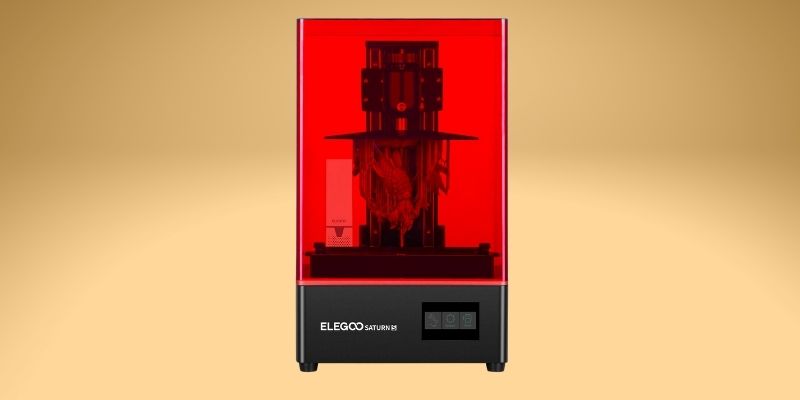
Pros
8.9-inch 4k monochrome LCD.
Excellent print quality.
Cons
No resin fill level indicator.
A souped-up, super-sized complement to Elegoo’s ever-popular and rightly lauded Mars printers, the Elegoo Saturn is a hulking MSLA resin printer.
The Mars was always a tough act to follow, but Elegoo went the extra mile to offer a mid-to-large build volume without compromising speed or quality. On the contrary, an upgrade to an 8.9-inch 4K monochrome LCD guarantees virtually the same level of detail (3 tiny microns in the Elegoo Mars’ favor) while offering print speeds flirting with 1 second per layer. That equates to roughly 60% faster than the Mars 2 Pro.
These improvements allowed Elegoo to balloon the build volume to 192 x 120 x 200mm, three times that of the Mars 2 Pro. Best of all, Elegoo finds a special berth in the resin 3D printer space with a machine boasting a reasonably large build volume that doesn’t cost an arm and a leg.
The print quality stacks up on par with the Mars printers. You get all the lovely detail and precision you’d expect from a quality resin printer on both small and larger parts. Smooth setup and consistent results will see you printing within minutes. Even the manual bed leveling process is, dare we say, easy.
So, who’s best served snapping up an Elegoo Saturn? Those partial to bringing larger, complex custom miniatures and figurines to life with buckets of detail to boot, or multiple copies of the same detailed part in one sitting.
For us, the Elegoo Saturn is also an interesting proposition for small businesses looking for a cost-effective, fine detail prototyping rig that’s fast and reliable, or a machine to add to a high-productivity small-scale printing farm.
The asking price may be a little steep for first-timers, likely better served with a $200 to $300 entry-level printer. But, it’s a top option for those looking for a second printer or a first, pain-free dip into high-res resin printing after cutting their teeth on an FDM printer.
Creality CR-10 V3
- Price: Check on Creality Official Store here / Amazon here
- Build volume: 300 x 300 x 400 mm
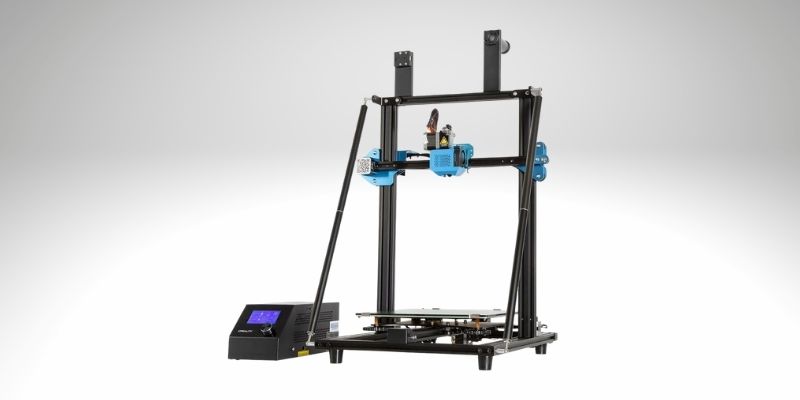
Pros
Massive build volume.
Reliable print quality.
Affordable.
Cons
Manual bed leveling.
Slow-heating bed.
A successor to the Creality CR-10 V2, the Creality CR-10 V3 is upgrades galore, with Creality pinpointing several areas ripe for improvement and delivering.
Leading the upgrade charge is a Titan direct drive extruder, transforming filament loading and retraction doddle, which translates to less unwanted stringing and clogging. Alongside, an improved all-metal frame and sturdy cross brace give the Titan extruder all the rigidity to tame wobble.
The V3 also has all the great features found on the CR-10 V2. Among them is a hefty 300 x 300 x 400 mm build volume. The bed size outclasses most sub $500 3D printers and delivers enough printing real estate for even the most towering hobby projects.
We found little in the way of complaints regarding the Creality CR-10 V3’s print quality. The machine fares equally well with PLA and TPU, with consistency a real highlight from one print to another. Decorative pieces, models, and figurines all come out great on Creality CR-10 V3.
Despite ticking a lot of boxes, there’s still room for improvement. The rotary knob controls feel outdated at this point, especially with other Creality CR printers sporting touch screens. The gnarl of cables linking to the control unit, which requires careful placement to avoid disrupting the printing process, can prove tedious. Finally, Creality weaved in all that’s needed to upgrade to automatic bed leveling with a BL Touch sensor, but not installing one from the get-go borders on a teasing slight.
If the comparatively stingy build volume of other $500 3D printers is likely to cramp your printing style, and you don’t mind minor convenience drawbacks, the Creality CR-10 V3 will serve you well.
Buyer’s Guide – Things To Consider For a 3D Printer Under $500
While $500 gets you a good home 3D printer these days, you probably won’t get everything you ever want in this price range.
But, if you prioritize a certain factor, for example a pre-assembled, beginner-friendly 3D printer you can start right away with, or a large build area, you can have those in a sub-$500 3D printer.
Assembly
3D printers are available either fully assembled, semi-assembled, or in kits. In the under $500 range, you’ll likely sidestep kits entirely and land a semi-assembled printer, perfect if a lengthy assembly process sounds too daunting. Resin printers under $500 ship almost exclusively fully assembled, while you’re unlikely to find a fully-assembled FDM, if only for the complexities and cost of shipping a fully raised printer.
Printing Technology
$500 limits you to two printing technologies: FDM and resin. FDM, or fused deposition modeling, is the classic printing technique whereby an extruder heats filament then deposits it in layers to form a 3D model or part.
On the other hand, resin uses a light source to cure liquid resin layer by layer into a finished print. Makers favor FDM for its low-cost and resin printers for their ability to create high-resolution, detailed prints.
Enclosed or Open Design
Opting for an open or enclosed 3D printer under $500 depends on what type of filament you hope to use. For PLA, we recommend an open design, while for ABS, you’re better served with an enclosed chamber due to the need for a stable thermal environment. As we near $500, we tend to find a few more enclosed options than budget printers, but most likely have open designs.
Build Volume
Build volume is the size and scope of prints a printer can conceivably make. There’s no ideal build volume per se; it comes down to what type of printers you have in mind. The logic is clear: a larger build volume gives you more possibilities for bigger-sized parts or even printing larger quantities of the same part. For $500, you’ll find both medium and large build volume printers, so buy according to your needs.
Connectivity
Connectivity determines how you feed a printer with the required sliced file to complete a print. SD card readers are par for the course at $500, and you’ll also find printers extend connectivity to USB. A few outliers offer Wi-Fi, but this is by no means standard at $500, so double check before buying if wireless connectivity is essential.
Bed Leveling
Bed leveling is a crucial part of the printing process, giving a printer a precise lay of the land to deliver a consistent and stable first layer, and by extension, a quality print. A printer with automatic bed leveling is rare at this price point, but they do exist, such as the Creality CR-6 SE.
Don’t let manual bed leveling put you off, though: manufacturers go to length to make the process straightforward. Our picks for the best 3D printer under $500 are unlikely to pose any issues, even for beginners.
Read more: the best auto-leveling 3D printers
What Not To Expect in a 3D Printer Under $500
$500 printers are firmly aimed at the hobbyist market with leeway for small business and educational applications. These are designed to quickly create the most detailed or flawless prints, so it’s important to shape your expectations accordingly. These are not professional-grade printers, nor do they pretend to be.
This also extends to features. Automatic bed leveling, enclosed chambers, Wi-Fi connectivity are all rarities at this price point. The same applies to compatible filaments. At $500, you are very much limited to PLA, resin, TPU, and possibly ABS if a closed chamber is involved. Don’t expect to print using exotic filaments.
3D Printer Under $500 Applications
Home Use Applications – models, miniatures, figurines, decorative and displays pieces, functional household items (vases, pen holders, cable holders, containers, etc.).
Small Business Applications – inexpensive prototyping, high-tolerance batch printing, small-scale printing farms.
Schools and Educational Applications – low-cost, reliable learning machines.
What you can’t print for under $500 – professional, highly detailed printing for fields such as dentistry, biomedicine, and other tight-tolerance applications.
Other price ranges you may be interested in:
